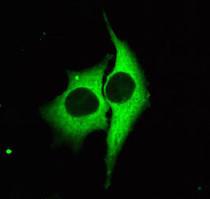![In human cells, fluorescent reporting of miRNA activity was coupled with CRISPR/Cas9 genome-wide loss-of-function screening to uncover a new miRNA mechanism, an Argonaut phosphorylation cycle that negatively regulates miRNA/mRNA target association but ensures global efficiency of miRNA-mediated gene silencing. [UT Southwestern Medical Center]](https://genengnews.com/wp-content/uploads/2018/08/Jan242017_UTSouthwesternMedCtr_GlowingCells7715712713-1.jpg)
In human cells, fluorescent reporting of miRNA activity was coupled with CRISPR/Cas9 genome-wide loss-of-function screening to uncover a new miRNA mechanism, an Argonaut phosphorylation cycle that negatively regulates miRNA/mRNA target association but ensures global efficiency of miRNA-mediated gene silencing. [UT Southwestern Medical Center]
In a target-rich environment, it is better to roam from target to target, racking up “kills,” than it is to indulge in overkill on any one target. A would-be microRNA (miRNA) ace might even sacrifice careful aim in order to engage multiple targets more efficiently. That’s roughly the logic of miRNA-mediated gene silencing. In the cellular skies, there are relatively few miRNAs, and a great many messenger RNA (mRNA) targets. So how do miRNAs pair up with one mRNA after another to turn down the production of proteins?
To answer this question, molecular biologists at UT Southwestern Medical Center (UTSW) combined CRISPR/Cas gene-editing technology a traditional method of making a miRNA target produce a fluorescent green protein. When they did so, they discovered a new maneuver in the miRNA pathway. Called Argonaute phosphorylation, this maneuver enables a miRNA to switch from one mRNA target to the next more efficiently.
“Our research addresses a fundamental question regarding how a miRNA is able to regulate a large set of target mRNAs, even though the miRNA is greatly outnumbered,” said Joshua Mendell, Ph.D., professor of molecular biology at UTSW.
The new research appeared January 23 in the journal Nature, in an article entitled, “An Argonaute Phosphorylation Cycle Promotes MicroRNA-Mediated Silencing.” It explained that the UTSW opted to use CRISPR/Cas9 to interrogate the miRNA pathway rather than RNA interference. The authors noted that in studies of human cells, the use of RNA interference screens is less than optimal because miRNA pathways shame common molecular machinery.
“By using iterative rounds of screening, we reveal a novel mechanism whereby target engagement by Argonaute 2 (AGO2) triggers its hierarchical, multi-site phosphorylation by CSNK1A1 on a set of highly conserved residues (S824–S834), followed by rapid dephosphorylation by the ANKRD52–PPP6C phosphatase complex,” wrote the article’s authors. “Although genetic and biochemical studies demonstrate that AGO2 phosphorylation on these residues inhibits target mRNA binding, inactivation of this phosphorylation cycle globally impairs miRNA-mediated silencing.”
The miRNA pathway is critically important to health and disease, serving as a kind of volume control for genes, dialing down the expression of specific proteins, said Dr. Mendell. UTSW researchers have previously found, for example, that defects in the miRNA pathway contribute to certain childhood cancers. Also, specific miRNAs can accelerate or inhibit cancer by regulating tumor suppressor or tumor-promoting genes. Finally, miRNAs play important roles in many other diseases, including heart disease.
CRISPR gene-editing technology allowed the scientists to switch off a different gene in each cell across millions of cells. Cells became more fluorescent when genes that impacted the miRNA pathway were switched off, leading scientists to the discovery of the new phosphorylation mechanism involved in controlling miRNA-target interactions.
In addition to shedding new light on the miRNA pathway, researchers say the distinctive combination of techniques used to decipher the pathway should be widely applicable to other biological questions, allowing labs to quickly identify critical components of important genetic pathways.
“This study represents the first time this experimental strategy has been used to study the miRNA pathway on a genome-wide scale,” noted Dr. Mendell. “It is a very powerful approach. This work lays out a methodology that could be used to study many different biomedical problems.”






